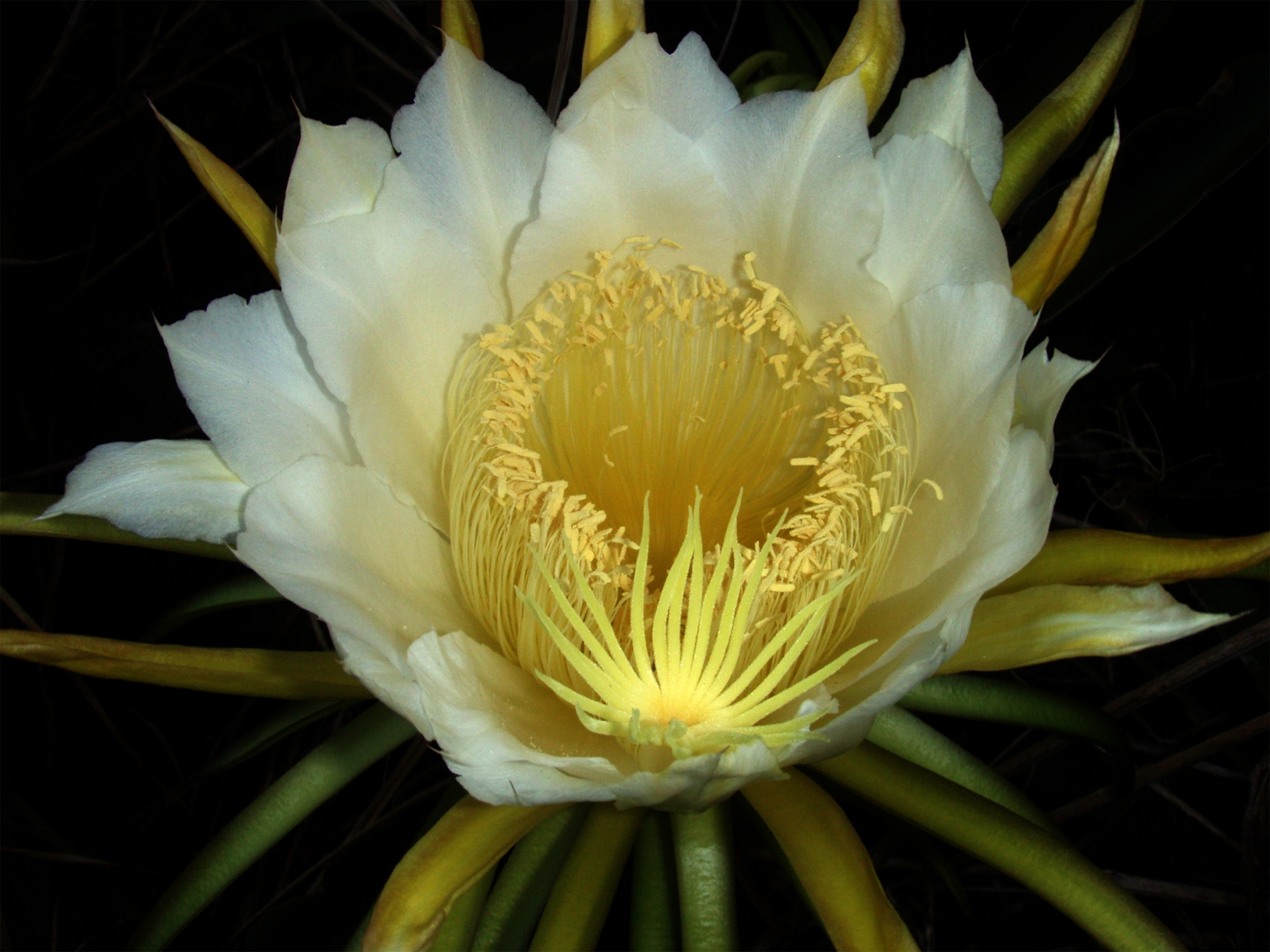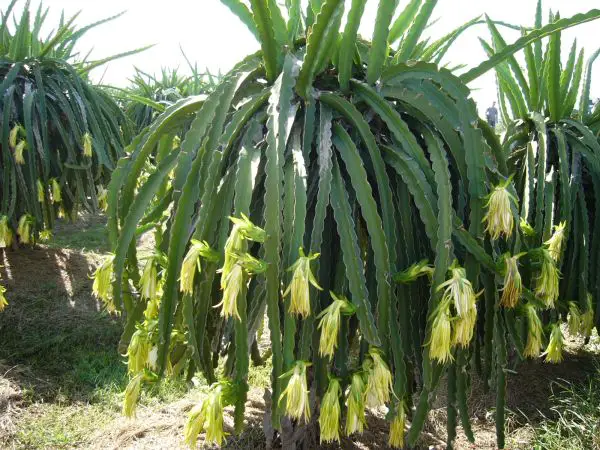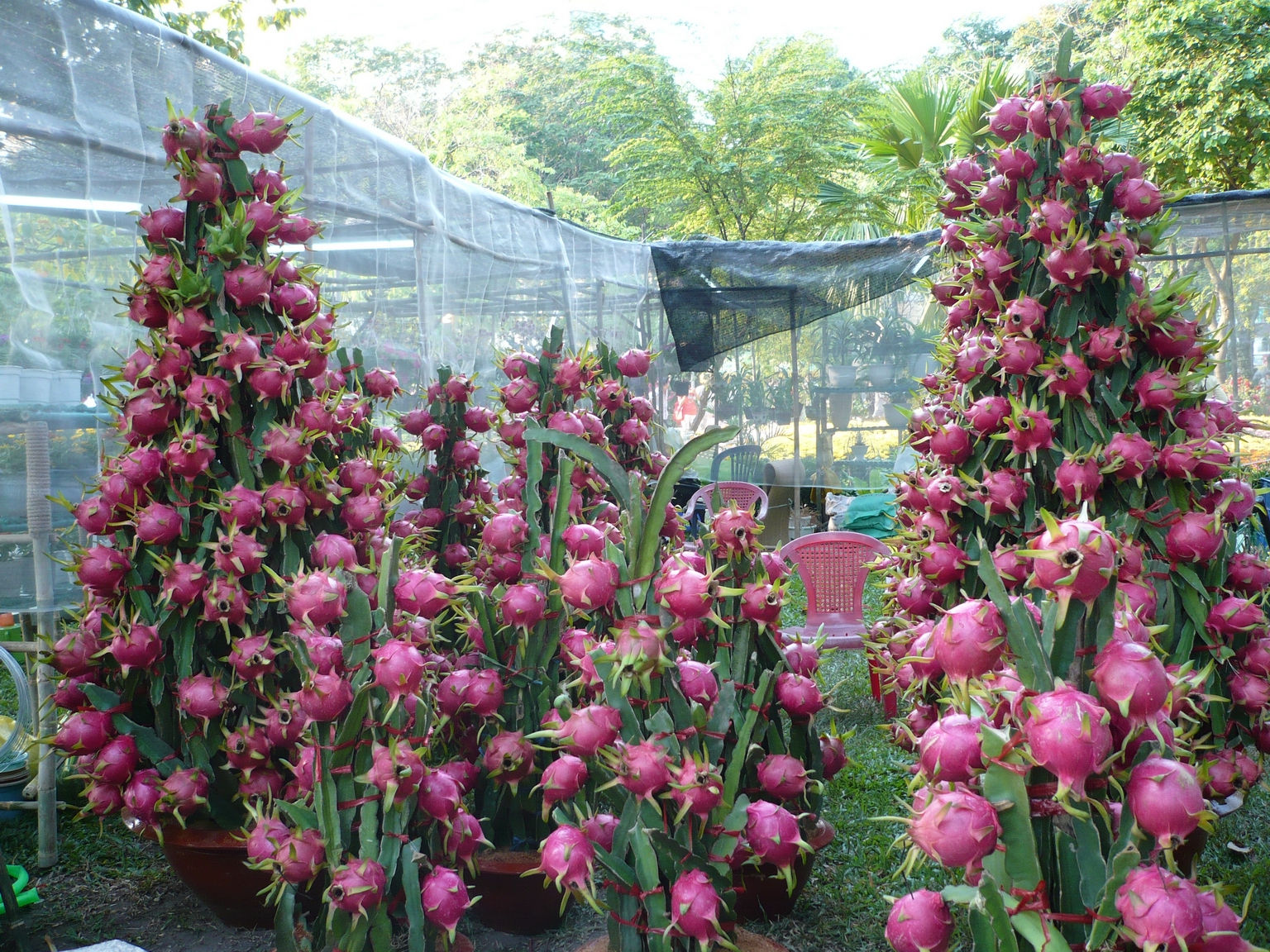Dragon fruit, which is a tropical fruit that has become more popular during the last several years, grows from several types of cacti. The Hylocereus undatus produces dragon fruit that has white pulp and a pink peel. Dragon fruit is also referred to as pitaya, pitahaya, and strawberry pear. This plant has been cultivated in many tropical regions throughout the world during the late twentieth century. Although dragon fruit is a tropical fruit that has a very exotic appearance, it is actually possible to grow this fruit at home.
To successfully grow dragon fruit in a container, plant a Hylocereus undatus cutting in a container filled with sandy soil. Because Hylocereus undatus is a vining cactus, it is important to provide your plant with sturdy support in its container. Add enough water to keep the top inch of the water moist and put your cuttings in the shade until they begin to grow. At this point, you can move the plant into an area that is exposed to more sunlight. Your Hylocereus undatus will continue to grow and should produce fruit within a year or two.
The rest of this article will discuss how to successfully grow your own dragon fruit in containers. This blog post will mainly focus on growing Hylocereus undatus. However, many care tips discussed in this article also apply to other dragon fruit plants such as Hylocereus guatemalensis.
About Hylocereus undatus
Hylocereus undatus, which is also known as the Night-Blooming Cereus, is a species of vining cacti that grows hemiephytically. This means the plant’s seeds germinate in a canopy of trees such that the plant begins its life as an epiphyte. Then the plant sends roots downward until they make contact with the ground. The stems are green and have three ribs.
Hylocereus undatus is one of the 15 species of cacti belonging to the Hylocereus genus. Like other plants belonging to the Hylocereus genus, Hylocereus undatus is native to Central and South America. However, this plant has escaped from cultivation in many regions and is now considered invasive in many parts of the world including China, Australia, South Africa, Florida, Hawaii, and many islands in the Pacific Ocean (Oviedo Prieto et al., 2012).
Hylocereus undatus Blooms
The flowers produced by the Hylocereus undatus are quite large and very beautiful. This plant only blooms one night per year. The blooms will typically stay open during the very early morning hours. The flowers start out as buds and bloom about two weeks after the bud forms.

Hylocereus undatus Fruit
After a Hylocereus undatus blooms, it must be pollinated in order for the plant to produce fruit. There are several varieties of Hylocereus undatus that self-pollinate. When purchasing your dragon fruit plant, ask the seller whether the variety they are selling is an easy fruit setter and whether it needs to be hand-pollinated. It is generally easier to grow dragon fruit from a plant that self-pollinates than those that require hand pollination.
The following YouTube video describes how to hand-pollinate a dragon fruit plant.
After flowering and pollination, it takes about 35 to 40 days for the plant to produce mature fruit. The plant will continue to bear fruit for about five months each year. This period typically occurs from early summer to mid-fall. Proper care, which will be discussed in this article, will encourage the plant to continue bearing fruit.
About Dragon Fruit

The inside of a dragon fruit grown from a Hylocereus undatus contains white, fleshy stuff that contains black seeds. This is the part of a dragon fruit that you eat. Like many types of fruit, dragon fruit is juicy. Dragon fruit has a slightly sweet taste that some people describe as a blend of kiwi and watermelon. The black seeds have a nutty flavor.
Dragon fruit can be eaten on its own or you can add it to fruit salads and smoothies. You can also grill dragon fruit.
It is important to note that there are several species of cacti that produce dragon fruit. The fruit will look different depending on the type of plant you grow. The table below summarizes some of these differences.
| Plant Variety | Peel Color | Pulp Color |
|---|---|---|
| Hylocereus undatus | Red | White |
| Hylocereus triangularis | Yellow | White |
| Hylocereus costaricenes | Red | Red |
| Hylocereus polyrhizus | Red | Red |
| Hylocereus ocamponis | Red | Red |
| Selenicereus megalanthus | Yellow | White |
| Cereus triangularis | Yellow | White |
| Acanthocereus pitajaya | Yellow | White |
| Cereus ocamponis | Red | Red |
Propagating Hylocereus undatus
Hylocereus undatus can be propagated from stem cuttings or seeds. Plants grown from cuttings tend to grow faster and produce fruit more quickly than plants grown from seeds.
Propagating Hylocereus undatus From Cuttings
Propagating Hylocereus undatus from cuttings is an easy way to start growing your own dragon fruit. The cutting root fairly easily. The follow YouTube video describes how to plant dragon fruit cuttings.
Propagating Hylocereus undatus From Seeds
You can grow Hylocereus undatus from seeds extracted from fruit purchased at the grocery store. Start by using a spoon to remove some of the fleshy fruit. Then put the fruit in a glass containing sugar dissolved in water. The sugar water will facilitate fermentation which makes extracting the seeds easier. Allow the fruit to rest in the sugar water for 48 hours. Then put the mixture in a sieve and use running water to remove the pulp and retain the seeds. Finally, put the seeds on a clean paper towel and allow them to dry in shade for 48 hours (Ortiz et al., 2018).
Fill seedling starter trays with cactus soil and moisten (but don’t saturate) the soil. Then use a spoon to put the dragon fruit seeds in the top 1/4-inch of soil. Mist the top layer of soil and put a plastic cover over the tray. This will trap moisture and heat. Place the tray near a sunny window or under grow lights. The seeds should sprout within a month.
It can take up to six years for Hylocereus undatus grown from seed to produce fruit.
Ideal Temperature Range For Hylocereus undatus
Although Hylocereus undatus prefers to grow in a tropical rainforest, these plants will successfully produce dragon fruit in subtropical and temperate climates. In the United States, Hylocereus undatus can be grown outdoors in USDA Hardiness Zones 10a through 11. They prefer warm temperatures but begin to wilt if the temperature exceeds 100°F for an extended period of time.
Hylocereus undatus can be damaged if exposed to temperatures below freezing for an extended period of time. However, these plants can recover from light freezing damage (Crane and Balerdi, 2005).
Lighting Requirements For Hylocereus undatus
Like other species of cacti, Hylocereus undatus grow best when they are exposed to plenty of sunlight. They will grow well in the open, but Hylocereus undatus does like some protection from the harsh afternoon sun as this more closely mimics their natural habitat.
Watering Requirements For Hylocereus undatus
Although Hylocereus undatus is a cactus, it is native to a tropical environment and requires a bit more water than most cacti. To encourage your Hylocereus undatus to bear fruit, ensure your plant receives about one inch of water per week during the summer. Some areas may get enough precipitation to cover the plant’s needs. Decrease the frequency of watering during the winter months.
Best Soil For Hylocereus undatus
Like many other types of cacti, Hylocereus undatus does best when grown in well-draining soil. A well-draining soil will minimize the amount of standing water, which can cause root rot, that develops at the bottom of your container. An ideal soil mix for Hylocereus undatus is comprised of 60 to 70 percent sand and 30 to 40 percent peat.
Fertilizing Hylocereus undatus
Hylocereus undatus does not require frequent feeding. Fertilize Hylocereus undatus once per year during the spring with a balanced fertilizer (10-10-10 or 20-20-20). Simply mix 3 tablespoons of fertilizer into a 5-gallon bucket and water the plant.
Hylocereus undatus will also benefit from compost applications. These plants will respond well to a spring and mid-summer application of compost.
Additional Care Tips
Selecting A Container For Your Dragon Fruit
Ideally, Hylocereus undatus should be grown in a container that is at least 10 inches deep and 18 inches wide if your goal is for the plant to produce dragon fruit. As you may expect, a larger container will allow you to grow a larger cactus that produces more fruit.
Trellis vs Cascading Dragon Fruit
Because Hylocereus undatus is a vining cactus, it requires supports for the aerial roots to “grab.” Otherwise, the plants will fall over as they are very top-heavy. A tomato cage works well for trellising your Hylocerus undatus. You can also build a more elaborate trellis like the one shown in the video below.
Alternatively, you can allow your Hylocereus undatus to grow downwards by placing your container on top of a tree stump or stand. This cascading effect makes it easy to harvest your fruit and requires less maintenance than growing Hylocereus undatus on a trellis.

Moving Your Dragon Fruit Plants
I recommend moving your Hylocereus undatus plants as little as possible because these cacti break apart very easily. The plant segments are connected by a very small piece of plant tissue that snaps easily when the plant is moved. If a segment does break off of your plant, simply stick it in the soil. Hylocereus undatus roots easily, and the broken segment will grow into a new plant.
Harvesting Dragon Fruit
Have you noticed that the dragon fruit sold at the grocery store is bland? This is because commercially grown dragon fruit is often harvested while the fruit is still green. By the time the fruit is transported to the grocery store, the peel has turned a nice red color, but the flavors did not develop any further. Harvesting dragon fruit at the right time results in a sweeter, more complex flavor profile.
Dragon fruit is ready to harvest once the outside of the fruit has turned red. The small “wings” on the side of the peel will also start to turn brown as the fruit ripens. The fruit should also feel soft (but not mushy) when gently squeezed.
Pruning Dragon Fruit
Hylocereus undatus responds well to pruning. Removing any dead or diseased parts of the plant will prevent disease and encourage the plant to grow more fruit. Prune after the plant has finished fruiting for the year.

